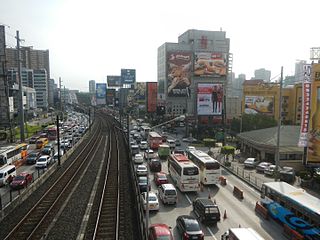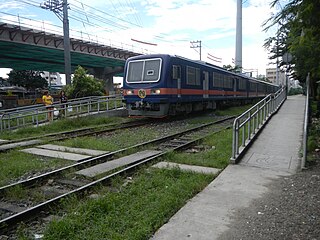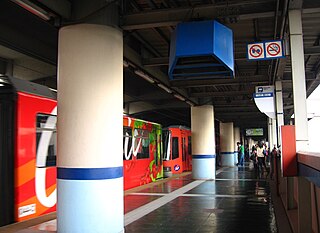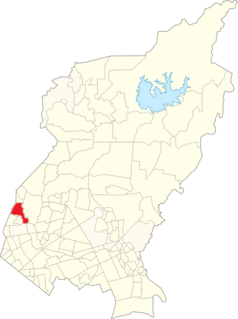It is proposed that this article be deleted because of the following concern:
If you can address this concern by improving, copyediting, sourcing, renaming, or merging the page, please edit this page and do so. You may remove this message if you improve the article or otherwise object to deletion for any reason. Although not required, you are encouraged to explain why you object to the deletion, either in your edit summary or on the talk page. If this template is removed, do not replace it . The article may be deleted if this message remains in place for seven days, i.e., after 18:34, 22 July 2019 (UTC). Find sources: "Quezon Avenue station" Line 9 – news · newspapers · books · scholar · JSTOR |
This article needs additional citations for verification .(March 2019) (Learn how and when to remove this template message) |
Quezon Avenue | |||||||||||||
|---|---|---|---|---|---|---|---|---|---|---|---|---|---|
| Metro Manila Subway Line 9 | |||||||||||||
| Location | Epifanio de los Santos Avenue cor. Quezon Avenue, Brgy. Pinyahan, Diliman, Quezon City | ||||||||||||
| Owned by | Department of Transportation | ||||||||||||
| Line(s) | Line 9 | ||||||||||||
| Connections | Transfer to Line 3 via southeast entrance and Quezon Avenue pedestrian overpass to Line 3 Quezon Avenue Station. | ||||||||||||
| Construction | |||||||||||||
| Structure type | Underground | ||||||||||||
| Disabled access | Yes | ||||||||||||
| History | |||||||||||||
| Opened | 2025 (planned) | ||||||||||||
| Services | |||||||||||||
| |||||||||||||
| |||||||||||||
Quezon Avenue Station is a planned station on the Metro Manila Subway Line 9 along the intersection of EDSA and Quezon Avenue. It will be an underground station like the rest of the line. The station is named after Quezon Avenue, a major thoroughfare in Quezon City.

Metro Manila Subway Line 9, formerly known as the Mega Manila Subway, is an underground rapid transit line currently under construction in Metro Manila, Philippines. The 36-kilometer (22 mi) line, which will run north–south between the cities of Quezon City, Pasig, Makati, Taguig and Pasay, will serve fifteen stations between the Quirino Highway and FTI stations. It will also serve as the country's second direct airport rail link, with a branch line to Ninoy Aquino International Airport. The line is designed to connect with the other urban rail transit services in the region, including Line 1, Line 3, and Line 7 at the North Avenue Common station, which is also currently under construction; the existing Line 2 and Metro Commuter Line; and the planned Line 5 and Line 8.

Manuel L. Quezon Avenue, more often called as Quezon Avenue, or simply Quezon Ave, is a 7.1-kilometer (4.4 mi), six-to-fourteen lane, major thoroughfare in Metro Manila named after President Manuel Luis Quezon, the second president of the Philippines. The avenue starts at the Quezon Memorial Circle and runs through to the Welcome Rotonda at the boundary of Quezon City and Manila.

Quezon City is the most populous and a highly urbanized city in the Philippines. It was founded by and named after Manuel L. Quezon, the 2nd President of the Philippines, to eventually replace Manila as the national capital. The city was proclaimed as such in 1948. However, since practically all government buildings are still in Manila, many functions of national government remained there. Quezon City held the status as the official capital until 1976 when a presidential decree was issued to reinstate and designate Manila as the capital and Metro Manila as the seat of government.
The station is planned to be built on the property of the Manila Seedling Bank, located at the northbound side of EDSA cor. Quezon Avenue, making it physically separate from its namesake Line 3 station of the Manila Metro Rail Transit System. [1] . The station is slated to open in 2025, when the line commences full operations [2]

Quezon Avenue Station is a station on the Manila Metro Rail Transit System Line 3. Quezon Avenue station is one of the many elevated stations that can be found on the line. The station is located in Diliman in Quezon City and is named after Quezon Avenue, one of the busy thoroughfares of Quezon City.

The Manila Metro Rail Transit System (MRT) is one of the two rapid transit systems serving Metro Manila in the Philippines along with the Manila Light Rail Transit System (LRTA). It originally began as a single line that was first opened in 1999 and became fully operational by the year 2000. Since then, most of the newly proposed rapid rail lines within Metro Manila that are not under the jurisdiction of the Light Rail Transit Authority is associated with the "MRT" brand. This includes the Line 9 and the elevated Line 7 which are being built as of March 2019.







